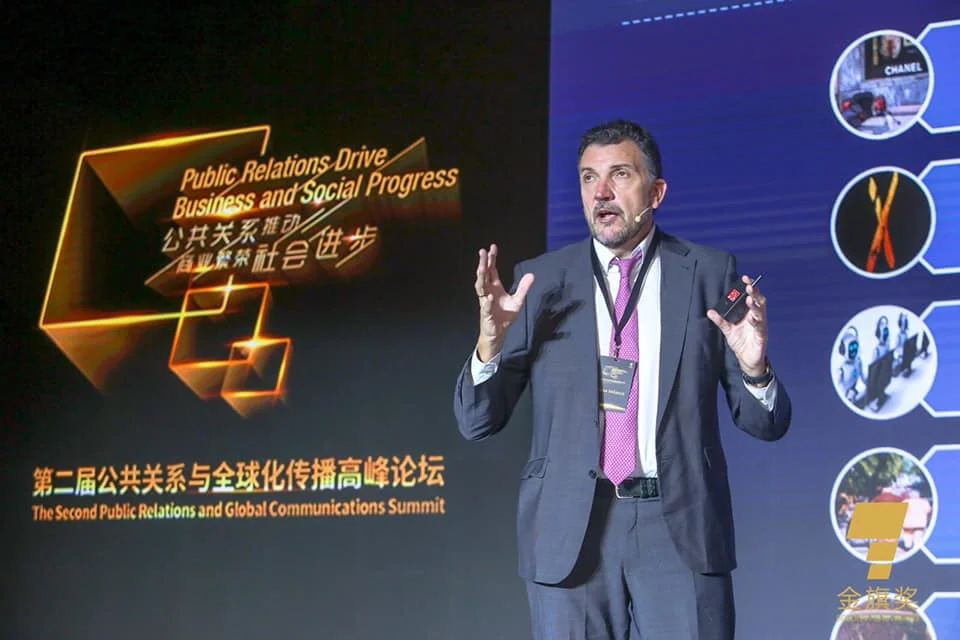In recent months, while serving my responsibilities as Chair of the Global Alliance for Public Relations and Communication Management, I had the opportunity to talk with colleagues from five continents and I have participated in PR conferences in Portugal, Norway, Spain, Argentina, Philippines, Indonesia and China. The first conclusion I drew from these experiences is that communicators speak a common language. Although there are different degrees of development, the profession is globalized.
The second conclusion is that we share concerns. The most cited is the need to strengthen the ethical framework of the profession, hit by phenomena as widespread as the fake news, post truth, alternative facts (an unfortunate expression of Kellyanne Conway, adviser to President Donald Trump) and some immoral behavior. This is precisely the objective of the 16 principles launched by the Global Alliance in collaboration with other international organizations in mid-2018.
Alex Malouf, Global Alliance board member, representative of the Middle East Public Relations Association (MEPRA) and member of the task force that agreed on the 16 principles, says: "Even though our work has to do with reputation, we have given ethics the importance and the time it deserves. This is changing, thanks in part to the efforts of various associations, which drive a renewed focus on putting ethics at the center of what we do and why we do it”. And Jean Valin, past chair of the Global Alliance and leader of the task force, adds: "Concepts such as credibility, transparency, trust and social responsibility, linked to the professional practice of communication, have a clear moral dimension".
This concern is linked with the weakness of the media, whose role as watchers of truth is in question in many countries and their credibility has been undermined. As much as we affirm that each person has become a media source, communicators still need the media, especially in their role as fact checkers. The more people that exercise the micro-power to communicate that technology has put in their hands, the more important the work of the media (whatever they are called) is when selecting, contextualizing, analyzing and distributing information through secure channels.
Another shared concern is the impact of digitalization on the Public Relations sector and its environment. This process is being used by marketing to recover spaces in the field of communication, in the heat of the search for immediate results and their greater experience with metrics. We are in a world of leads, closer initially to funnel marketing than to the communication strategy.
From this global and particular observation I have synthesized ten trends that, in my opinion, will affect the exercise of communication in the next twelve months.
1. The pressure for greater transparency
Not only there is more information, but it is easier to access it. There is a growing social demand for organizations, especially companies, to be more transparent, systematically offering the data, facts and strategies that shape their management and stance when crisis situations occur. The aim is that stakeholders can make their decisions with full knowledge of the cause.
2. The search for authenticity
The expansive growth of 'fake', in part because of its greater impunity, has given more value to 'the authentic'. Sincerity is one of the components of trust. Citizens rely more on those people, organizations and brands who express themselves with sincerity, who do not hide their vulnerabilities, who know how to recognize mistakes and who relate to others on an equal footing.
3. The growing importance of corporate purpose
José Antonio Llorente, founder and president of the Latin American reputation and public affairs consultancy LLORENTE & CUENCA, described it this way in an article published in the Spanish newspaper El País: "This change of era, in which artificial intelligence (AI) has an increasingly relevant role, far from being a threat, is an opportunity and a challenge for organizations to communicate and devote more time and resources to the intrinsically human, that which can never be automated. And this is when the corporate purpose is revealed as one of the key elements for the survival and profitability of organizations in this digitalized, hyperconnected and hypervulnerable environment".
The purpose connects the mission and vision by giving a collective sense that is superior to the organization. It is the expression of ‘why for’. The purpose must be authentic and impregnate all the processes, in such a way that storydoing acts as a guarantee for storytelling.
4. Good stories (well told and with a socially responsible purpose)
Walter Fisher developed his narrative paradigm in the 70s. In his opinion, a good story is better than a good argument. Fisher believes that human beings understand our life as a succession of narrations, each conceptualized as "a symbolic action -words and / or facts- that has sequence and meaning for those who live it, create it and interpret it".
In a hypersensitive environment, the stories that work best are those that have a soul, that is, that connect with feelings and human ambitions. Each story must include a piece of the corporate purpose, in such a way that the organization reveals its most human side.
The communicators are, essentially, the storytellers of their organisations. A story with shared protagonisms, interactions and ongoing construction. In fact, communicating through writing remains one of the most valued skills for a communicator, according to the Global Communication Report.
5. The micro-video boom
Wechat, the Chinese social network that has more than 1,000 million users in Asia, is full of short videos. There are hundreds of applications that allow you to create 10-second videos with a caption and soundtrack. On Facebook and Instagram the penetration of audiovisual formats also increases. This has a neuroscientific explanation (the brain is capable of processing a complete image in 13 thousandths of a second) and a functional one (it is easier to produce a photograph than a text). People like to see and see each other.
Short formats are imposed. It is difficult to capture the attention of audiences (increasingly the sum of individuals) by the enormous competition of information and opinion producers, channels and applications. It is essential to knock at the door of perceptions and, once open, to quickly enter the search for the emotions that unleash basic decisions in the processes of interaction between organizations and their public.
6. The omnichannel
With multichannel strategies, the relationship begins and ends in the same channel, but with omnichannel we seek to maintain a lasting relationship with clients that adapts to the medium that best suits them at all times. The aim is to improve the customer experience, in such a way that the customer journey is pleasant, while simultaneously generating involvement and loyalty.
This principle, which applies to marketing, should also be transferred to communication strategies. It is obvious that the contents have to adapt to the characteristics of each channel. In addition, such content must make sense separately and, at the same time, contribute to a common history. Omnichannel invites, then, transmedia initiates.
7. Co-creation
The best way to involve a person is not to make them feel like a link in the chain, but as part of the chain. A good example is the interface that allows the configuration of vehicles tailored by the client: each car is unique and utilises the creative capacity of those who buy it and will use it.
More and more brands are daring to build a story with their customers. They provide space, tools (computer applications in most cases) and, above all, the confidence to participate in campaigns or communication and marketing actions.
It is co-created from conversations, which are central to the life of any organization. Peter Senge, director of the Center for Organizational Learning at the Massachusetts Institute of Technology, says that "conversation is the basic or essential process that has always enabled cohesive human beings”. Let's talk, then, to create together.
8. The entertainment factor
The principles of journalism were and continue to be "inform, train and entertain". The problem is that some media companies have focused exclusively on the latter, which is undoubtedly the most profitable in the short term. This axiom may also apply to the content that we generate from communication departments. Do not give up on capturing attention because the competition is fierce.
Proof that the entertainment factor is increasingly present in communication actions is the growth of events. The entertainment approach facilitates the contextualization of the information and presents it in a format that is easier to consume. In addition, it brings various communication resources together in a single action. Often the ‘how’ is part of business.
9. Cooperation with other functions
If it is time for co-creation, it is also time for cooperation. The communicator is a natural silo breaker. Their responsibility is vertical (in the creation of the communication strategy) and transversal (in their interaction with all the departments of an organization or business units of a company). This naturally integrative nature is compounded by the need to converge with those other functions that have a more direct impact on the company's reputation, understood as the most valuable and often also the most fragile intangible.
Cooperation with marketing is essential so that the corporate and brand stories are consistent and effective. It is essential to collaborate with human resources in the field of talent engagement, and it is necessary to work with the compliance departments to facilitate the reporting of corporate governance. Communicators must always respond to the requirements of operations in the short term without losing the perspective of the long term that implies the management of reputation.
10. Accreditation of the value of communication
Organizations express their results primarily through numbers. In the world of the company there is no doubt about it. The communication sector must prove its contribution to the results through metrics.
Recently I listened to the master of communicators Antonio López, President of Honor of the Spanish Association of Communication Directives (Dircom), who assured us that "with the obsession for the metrics we run the risk of focusing only in the short term and neglecting the magic of a job that involves managing relationships, emotions, feelings and solutions to problems that are often not easy to measure”. But if the market asks for measurement, it will have to be measured. The key is to develop metrics that combine short and long-term objectives, because communication must be conceived as a basic component of sustainability, an objective that can only be served with long lights.
José Manuel Velasco
Chair of the Global Alliance for Public Relations and Communication Management

